Coronavirus (COVID-19): state of the epidemic - 4 March 2022
This report brings together the different sources of evidence and data about the Covid epidemic to summarise the current situation, why we are at that place, and what is likely to happen next.
Estimated Infection Levels and Case Numbers
Estimated Infection Levels
The reproduction number (R) is the average number of secondary infections produced by a single infected person. If R is greater than one the epidemic is growing, if R is less than one the epidemic is shrinking. The higher R is above one, the more people one infectious person might further infect other people and so the faster the epidemic grows. Please note that R is an indicator that lags by two or three weeks. For more information please visit the UK government website.
The UK Health Security Agency's (UKHSA) consensus estimate for R in Scotland as at 15 February is between 0.9 and 1.1. Both the lower and upper limits of the R value have remained unchanged since the last published figure (Figure 1) [2] [3].
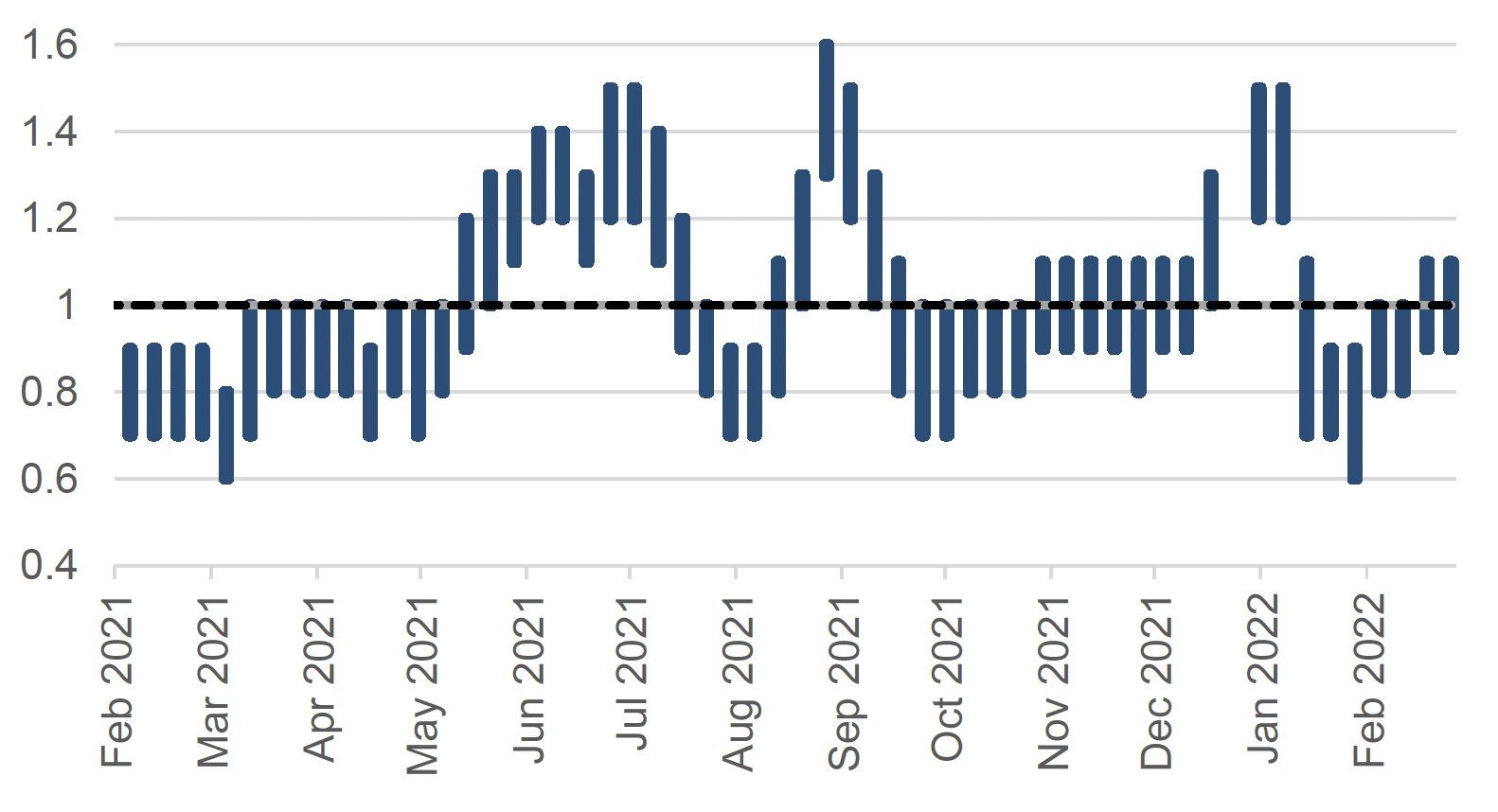
As at 15 February, the UKHSA's consensus view was that the incidence of new daily infections in Scotland was between 246 and 526 per 100,000 people. This equates to between 13,400 and 28,800 people becoming infected each day in Scotland[5] [6].
The growth rate reflects how quickly the numbers of infections are changing day by day. It is an approximation of the percentage change in the number of new infections each day. More information can be found on the UK government website.
The latest growth rate for Scotland as at 15 February was between -1% and 2%. The upper and lower limits have increased since the last published figure[7] [8].
Covid Infection Survey
The Covid-19 Infection Survey is a UK wide study carried out by the Office for National Statistics (ONS) and the University of Oxford. The survey invites private residential households to test whether they have the infection, regardless of whether they have symptoms, using a PCR test. Participants are also asked to provide a blood sample to test for antibodies. This means the study is unaffected by testing policy changes mentioned at the start of this report.
In Scotland, the percentage of people testing positive for Covid-19 increased in the week ending 26 February 2022, as seen in Figure 2. The estimated percentage of people testing positive for Covid-19 in the private residential population was 5.33% (95% credible interval: 4.78% to 5.93%)[9], equating to around 1 in 19 people (95% credible interval: 1 in 20 to 1 in 17). The latest peak was the highest since the start of the pandemic: 5.65% recorded in the week to 7 January 2022. This was higher than the two previous peaks of 2.29% recorded in the week to 11 September 2021 and 1.24% recorded in the week to 17 July 2021.
In the week 20 to 26 February 2022, estimates for the other nations of the UK are as follows and can be seen in Figure 2:
- In England, the percentage of people testing positive continued to decrease in the most recent week: 3.55% (95% credible interval: 3.41% to 3.65%), equating to around 1 in 30 people (95% credible interval: 1 in 30 to 1 in 25).
- In Wales, the percentage of people testing positive in private residential households decreased in the latest two weeks, but the trend is uncertain in the most recent week. The estimated percentage of people testing positive is 3.10% (95% credible interval: 2.63% to 3.61%), equating to around 1 in 30 people (95% credible interval: 1 in 40 to 1 in 30).
- In Northern Ireland, the percentage of people testing positive decreased in the most recent week: 5.79% (95% credible interval: 4.95% to 6.74%), equating to around 1 in 17 people (95% credible interval: 1 in 20 to 1 in 15).
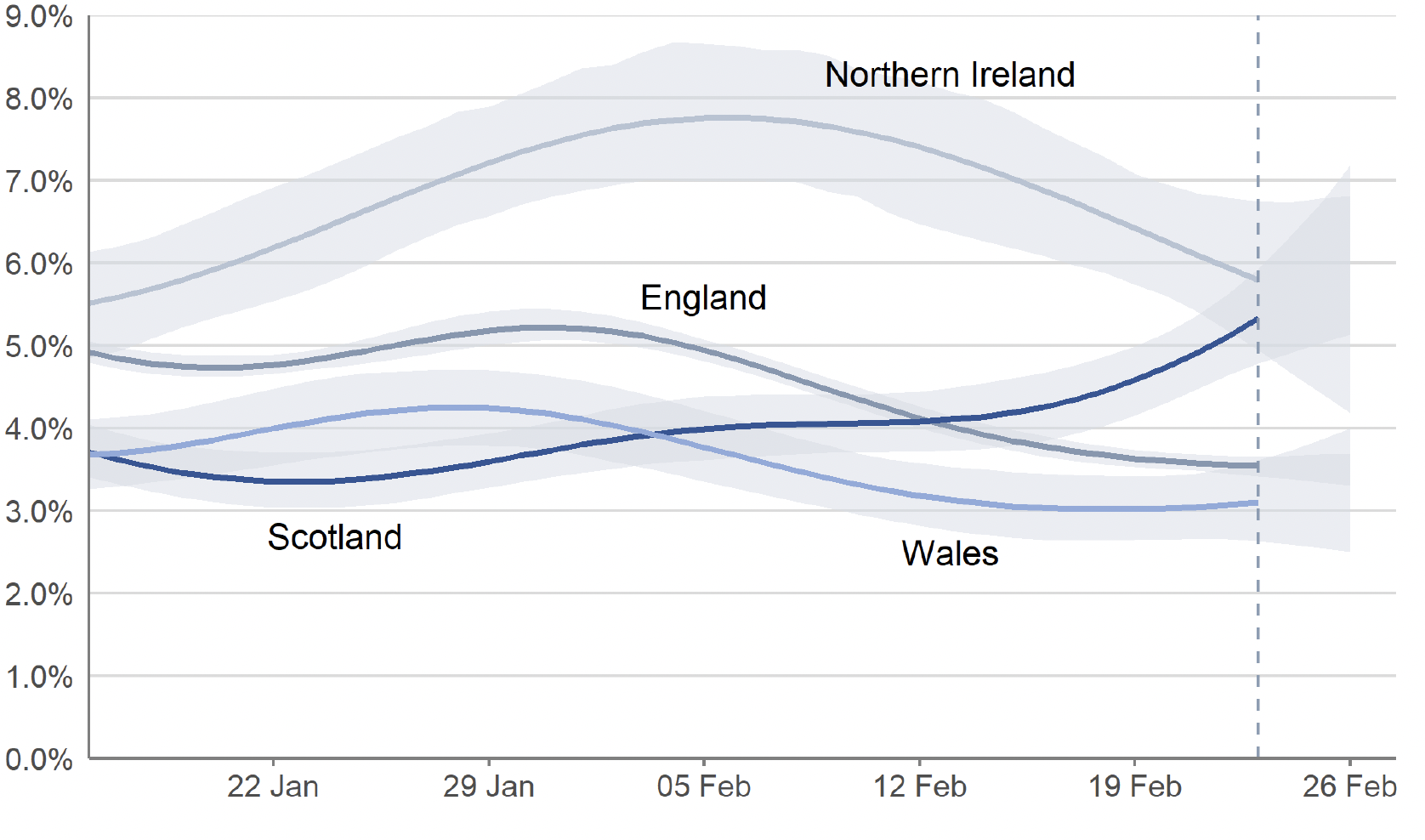
In Scotland, there are signs of an increase in the percentage of the population testing positive for Covid-19 in those around age 30 and those around age 60, in the week ending 26 February 2022. The trend is uncertain for children and younger adults due to wide confidence intervals. Meanwhile, the case rates (including reinfections) for those aged 60 or older continued to increase in the most recent week[10].
This increase in estimated infection levels in Scotland has correlated with the increasing prevalence of the Omicron BA.2 variant in Scotland since early February. According to the Covid-19 Infection Survey, the percentage of people testing positive with cases compatible with Omicron BA.2 in Scotland has increased in the most recent week to 26 February. The percentage of people testing positive with cases compatible with Omicron BA.1 has also increased in the most recent week (Figure 3). Omicron BA.2 is likely to have a growth advantage over Omicron BA.1[11].
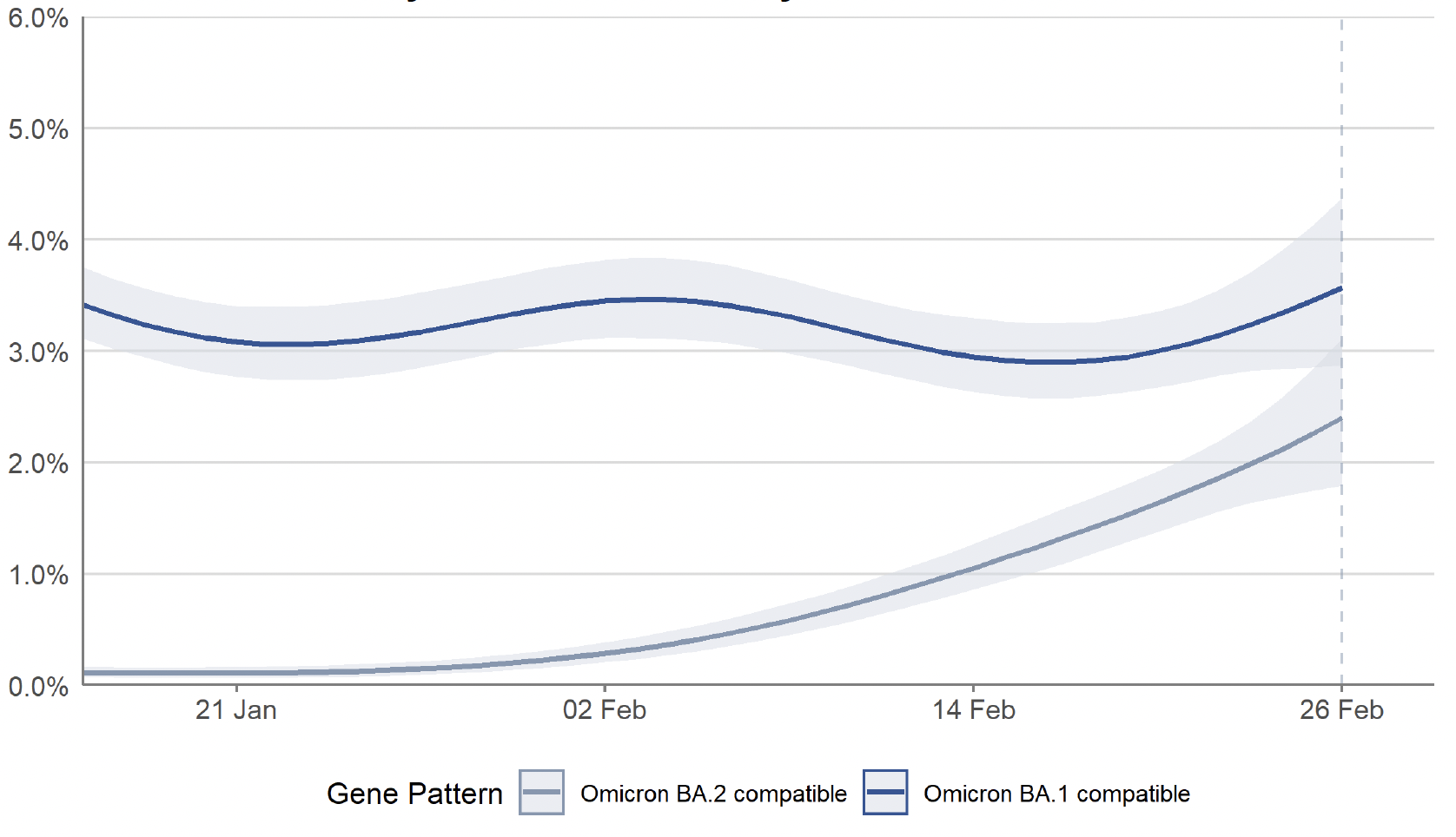
Wastewater Estimates
The Scottish Government has been working with the Scottish Environment Protection Agency (SEPA) to detect and analyse fragments of Covid-19 virus RNA in wastewater. The number of locations where the levels of SARS-CoV-2 in wastewater are monitored has increased to 141 sites around Scotland. In contrast to Covid-19 case records, virus shedding into wastewater is a biological process. This means that wastewater data is unaffected by factors that impact whether testing is done.
Nationwide, wastewater Covid-19 RNA levels have been fairly stable without showing any consistent trend in the last three weeks. The week ending on 28 February saw levels of around 64 million gene copies per person per day (Mgc/p/d) compared to 79 Mgc/p/d the previous week[12].
Compared to before December 2021, wastewater Covid-19 levels appear lower than anticipated given the known levels of Covid-19 activity. This effect may be due to the switchover from Delta variants to the new Omicron variant, and their shedding properties. Thus, Figure 4 shows only data from after the end of 2021, at which point the Omicron variant already represents almost all cases in Scotland. From this, we see a rapid decline from peak levels in early January with stable wastewater viral levels since late January and a slight increase over February[13].
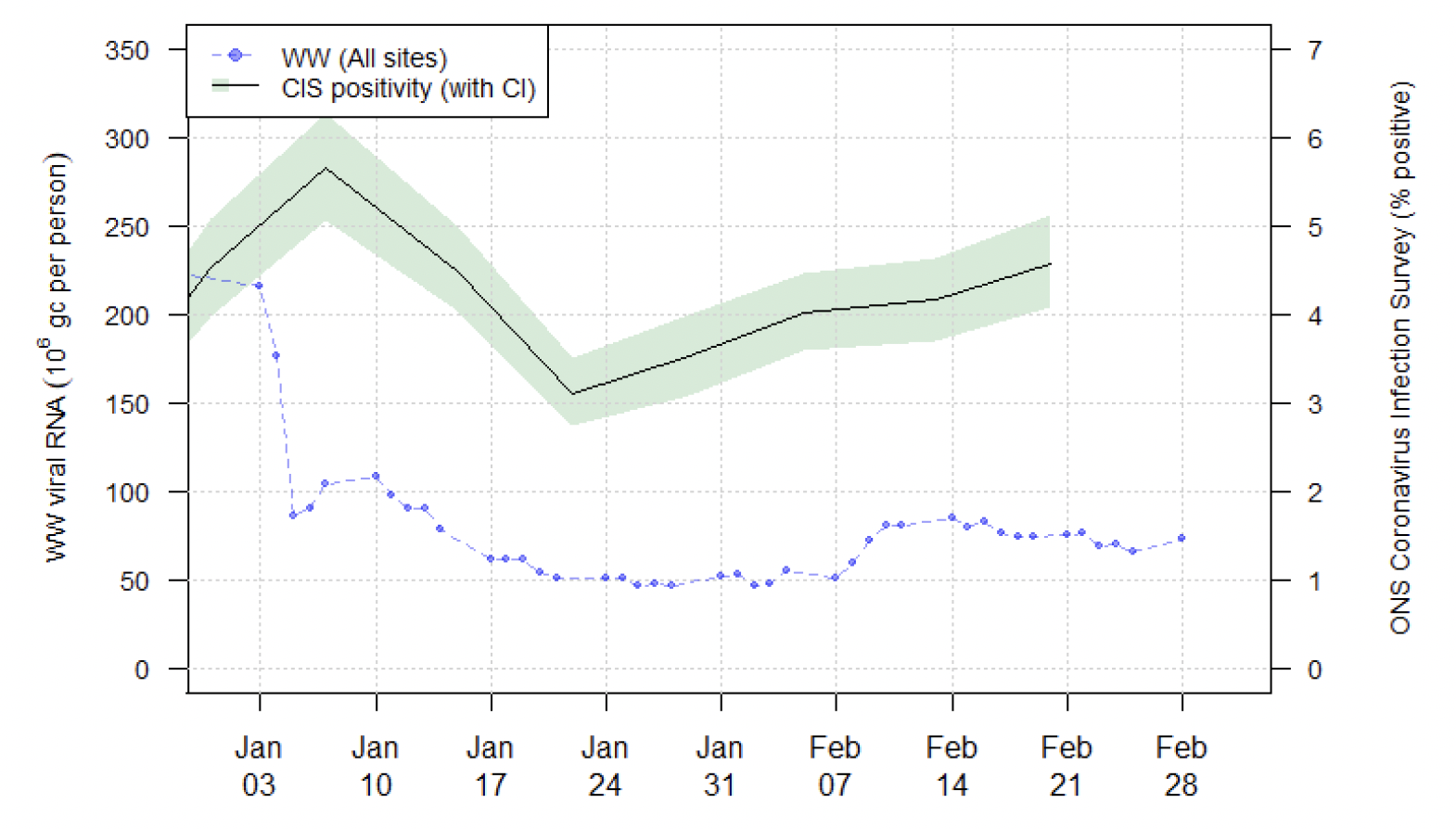
Covid-19 Cases
Please note that from 5 January, the Covid-19 case definition includes cases confirmed by either a PCR or LFD test, or both. Comparisons over time need to be made with caution. For more information on the difference between reporting and specimen date, please see this earlier publication.
From March 1, cases data includes reinfections (where a person has a positive test 90 days or more since their last positive test). For cases by specimen date, historical daily cases have been retrospectively updated to include reinfections, whereas for cases by reporting date reinfections were added to the total cumulative number on 1 March 2022 and will be included in daily reporting going forward. Reinfections have not been added retrospectively to data by reported date.
By reporting date[15], 6,030 cases (7-day average) were reported per day in the week leading up to 28 February. The seven-day average number of daily reported cases levelled off between mid to late January, and was decreasing at a slow rate until end of February. On 2 March, 8,725 cases (including reinfections) were reported, a slight increase from the previous day. However, the trend must be interpreted with caution due to the inclusion of reinfection cases from 1 March (Figure 5)[16].
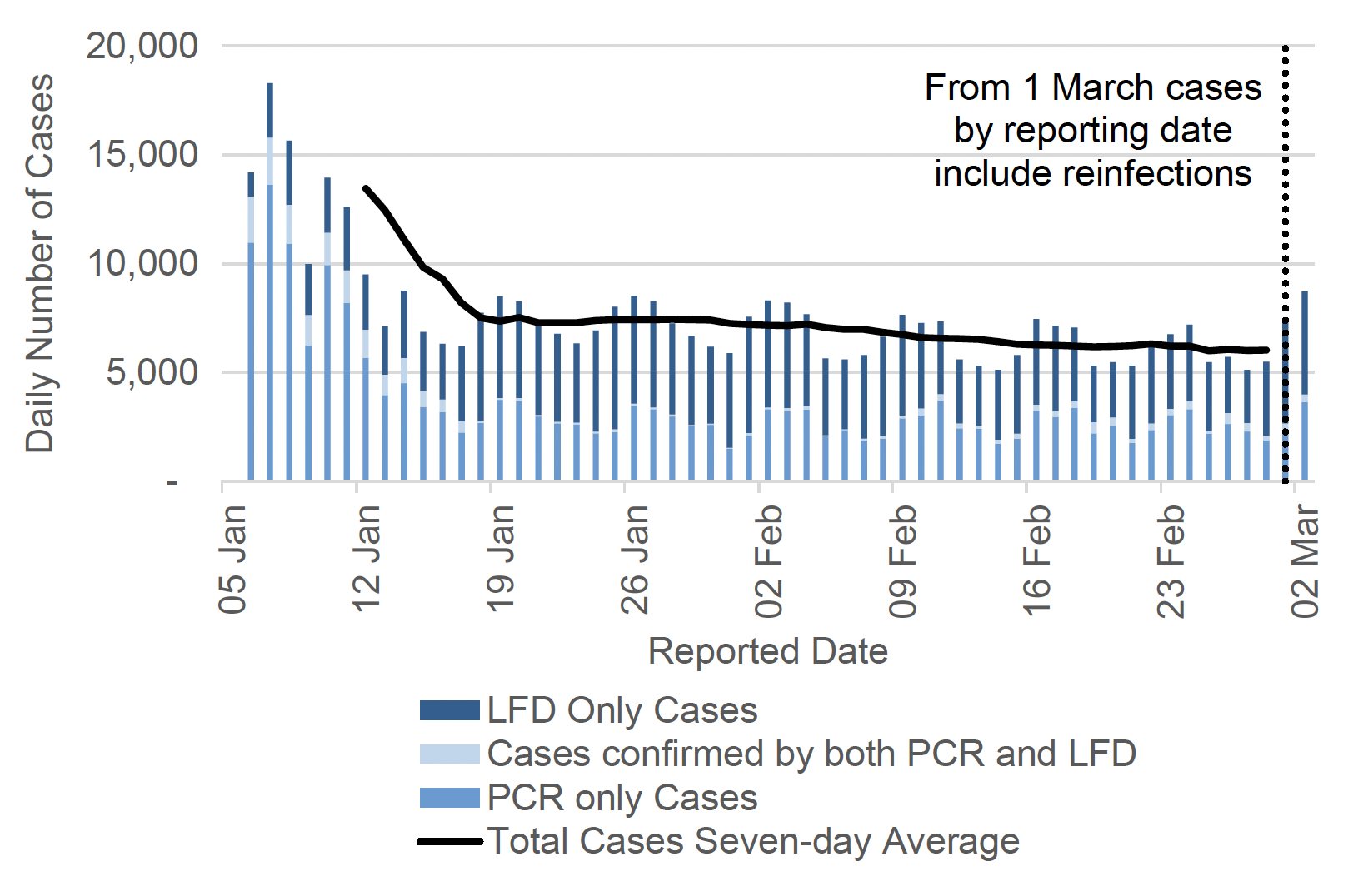
For comparisons over time it is more reliable to look at case rates by specimen date[18]. Up until 5 January, case rates by specimen date were only identifiable for cases confirmed by a PCR test, but following the change in testing policy, case rates by specimen date are now available for cases confirmed either by PCR or LFD test. Comparisons over this time period must be made with caution, as changes might reflect changes in testing behaviour rather than changing infection levels.
Following a sharp drop in the weekly rate of PCR or LFD confirmed Covid-19 cases (including reinfections) after the testing policy change on 5 January, the rate of decrease has slowed since mid-January. By specimen date, the seven-day combined PCR and LFD case rate (including reinfections) continued to decrease slightly in Scotland in the week leading up to 26 February. There were 827 weekly combined PCR and LFD cases per 100,000 population in the week to 26 February, which is a 4% decrease from 860 weekly cases per 100,000 on 19 February and a 9% decrease from three weeks previously (905 weekly cases on 5 February) (Figure 6)[19]. This remains a very high case rate compared to previous phases of the pandemic in Scotland.
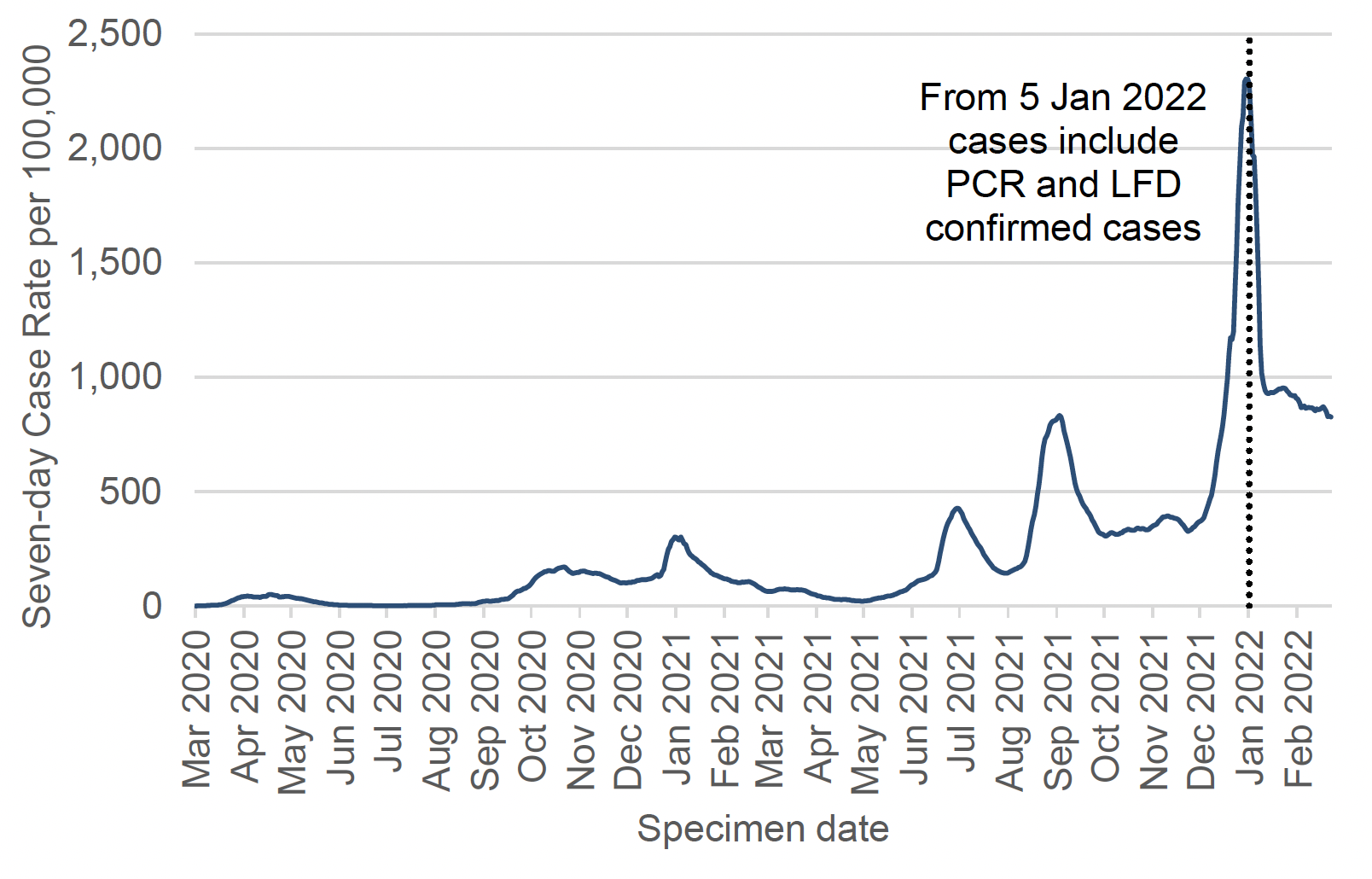
The week leading up to 26 February continued to see increasing case rates (including reinfections) among age groups 60 and older, with the biggest increases seen among those aged 80 or older increasing by 16% and the case rate among those aged 70 to 79 increasing by 7% compared to the week to 19 February [21]. In the same period, the case rate (including reinfections) has continued to slightly decrease or remain at similar levels for most age groups below 60. The exception was a slight increase in case rates among those aged between 2 to 4, 5 to 11 and 12 to 13, ranging between 4% and 12% compared to the previous week ending 19 February (Figure 7)[22].
As of 26 February, the highest combined PCR and LFD weekly case rate (including reinfections) by specimen date per 100,000 were observed amongst those aged 20 to 39, followed by those aged 40 to 49, 19 and younger, 50 to 59 and 60 to 69. The lowest weekly case rates were seen among those aged 70 to 79, and 80 or older.
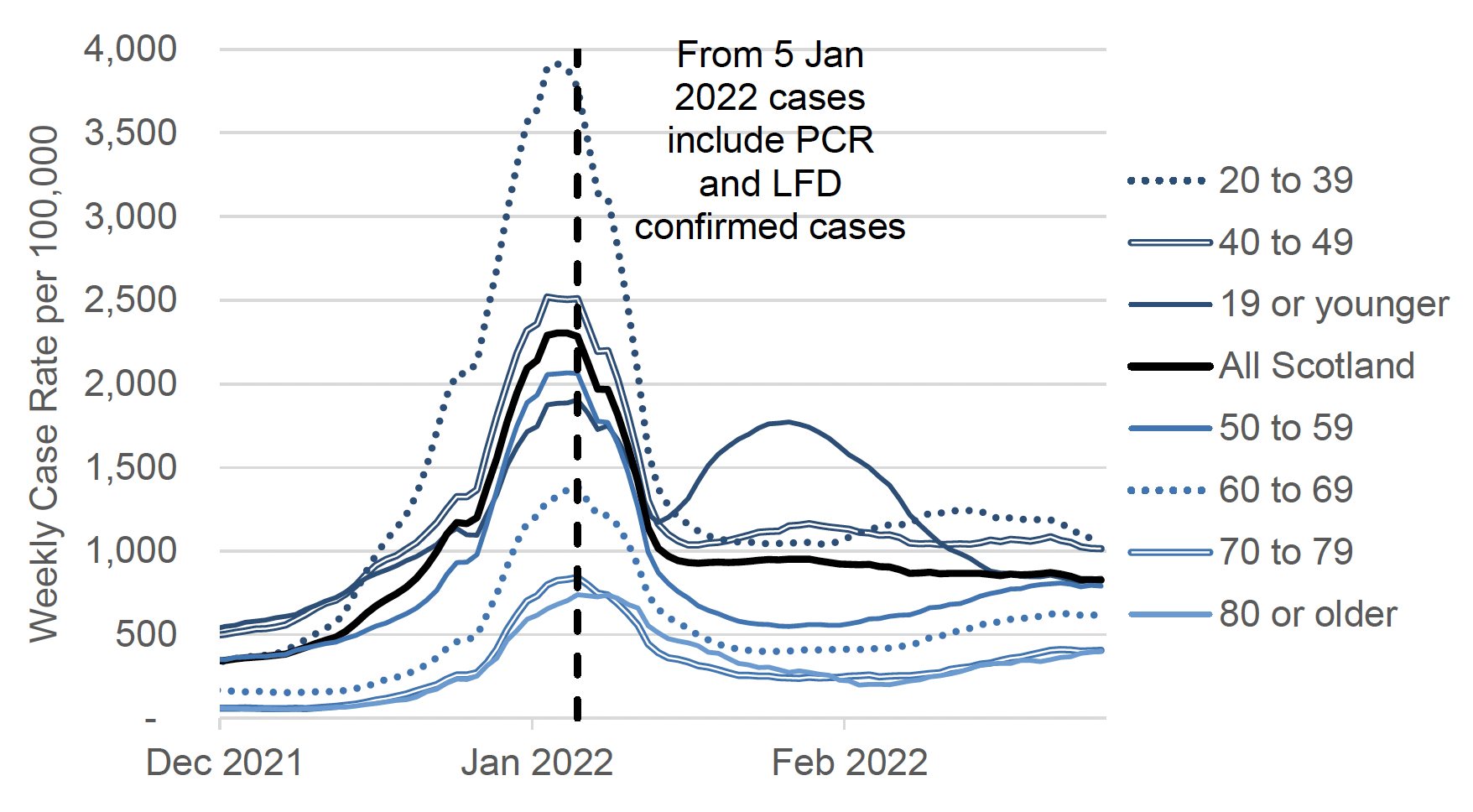
This is in line with the increasing numbers of Covid-19 cases in care home residents throughout February 2022. Weekly number of positive Covid-19 cases for residents in care homes has gone up by 154% from 197 in the week to 6 February to 500 in the week to 27 February. This is lower than the previous peak of 833 weekly cases in the week to 9 January 2022, and 641 weekly cases in the week to 10 January 2021[24].
Due to different case definitions across the UK, comparisons between countries cannot be made at this time. Cases data from Scotland and Northern Ireland includes both PCR and LFD test results. Cases data from Wales includes PCR only results, and cases data from England includes PCR, LFD and LAMP (loop-mediated isothermal amplification) test results.
Additionally, from 31 January 2022, case reporting in England and Northern Ireland has changed to an episode-based definition which includes possible reinfections. From 1 March 2022, multiple infection episodes with a 90-day threshold are also included in cases for Scotland. Public Health Wales has reported cases by 42-day infection episodes throughout the pandemic. It intends to move to a 90-day episode length in the coming weeks. Reported case numbers can be found on the UK Government Dashboard.
Due to the different case definitions outlined above, we have not included case comparisons across the four UK nations using data from the UK Government dashboard in this edition of the report. When these definitions are more aligned we will resume reporting on these comparisons. To compare estimated infection levels in private residential households across the UK, please see the previous section on the Covid-19 Infection Survey.
Reinfections
A reinfection is defined as a positive test 90 days or more after a previous positive test. This amount of time is set in order to be able to distinguish between viral persistence of the primary Covid-19 episode and a true reinfection.
The increase in the proportion of reinfections seen in late 2021 corresponds to the emergence of the now dominant Omicron BA.1 variant in the UK. The proportion of reinfections in Scotland when Omicron BA.1 was first detected on 29 November[25] was 0.8% percent of total cases. These are cases in individuals for whom it has been 90 or more days since their last positive Covid-19 test. The proportion of reinfections peaked on 4 January, at 9.1%, before decreasing slightly (Figure 8).
By specimen date, there was a total number of 3,873 reinfection cases confirmed by either a PCR or LFD test in the week leading up to 26 February. Reinfections represented 8.6% of total reported cases in the most recent week.
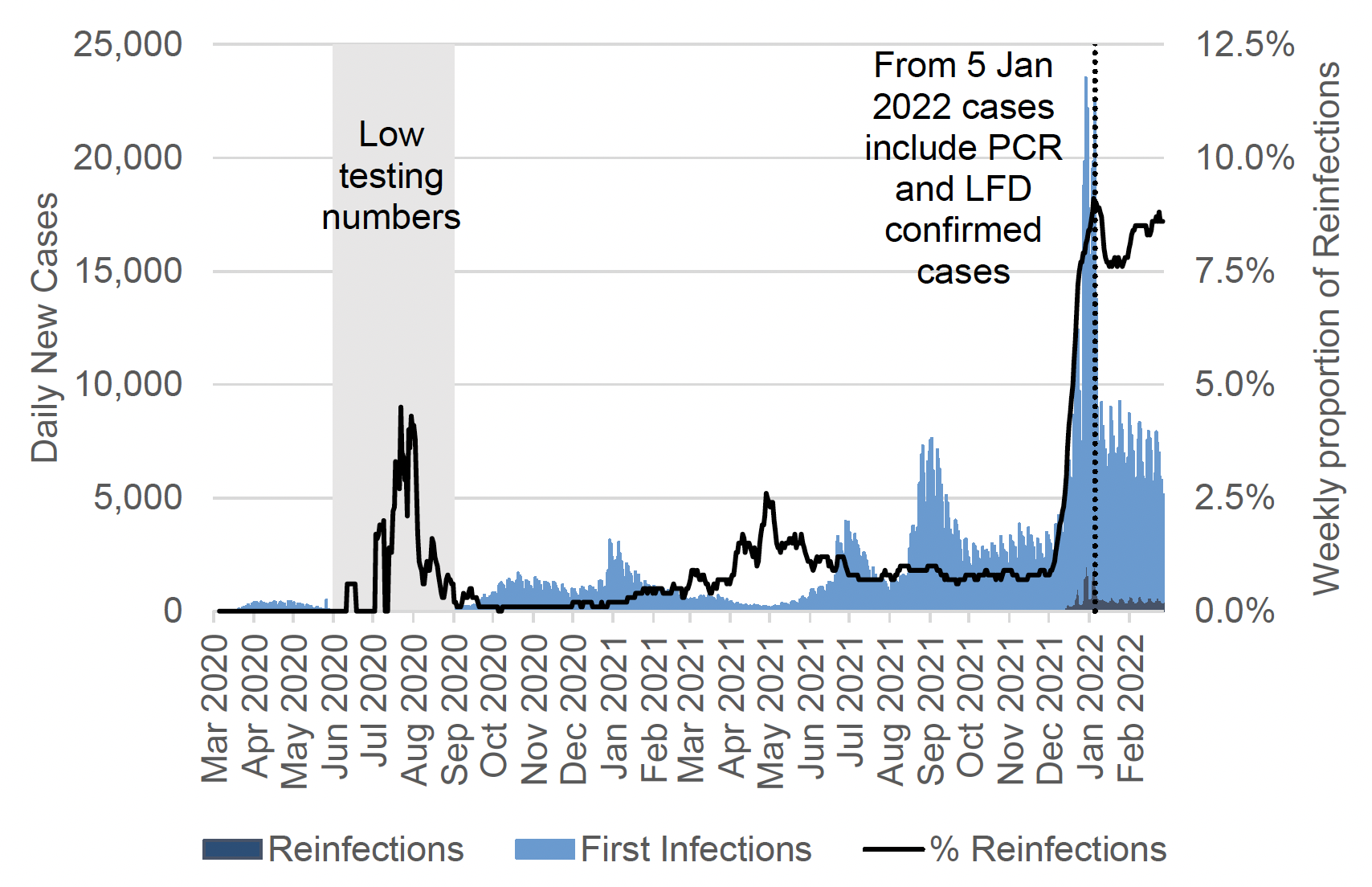
LFD Testing
After a decrease in the number of LFD tests that were reported between 27 December 2021 and 9 January 2022, there was a peak in reported LFD tests on 16 January 2022, with 810,225 reported tests[26]. The weekly total of tests reported in the week to 27 February decreased by 5% from the previous week leading up to 20 February. There were 593,828 reported tests in the week ending 27 February (Figure 9)[27].
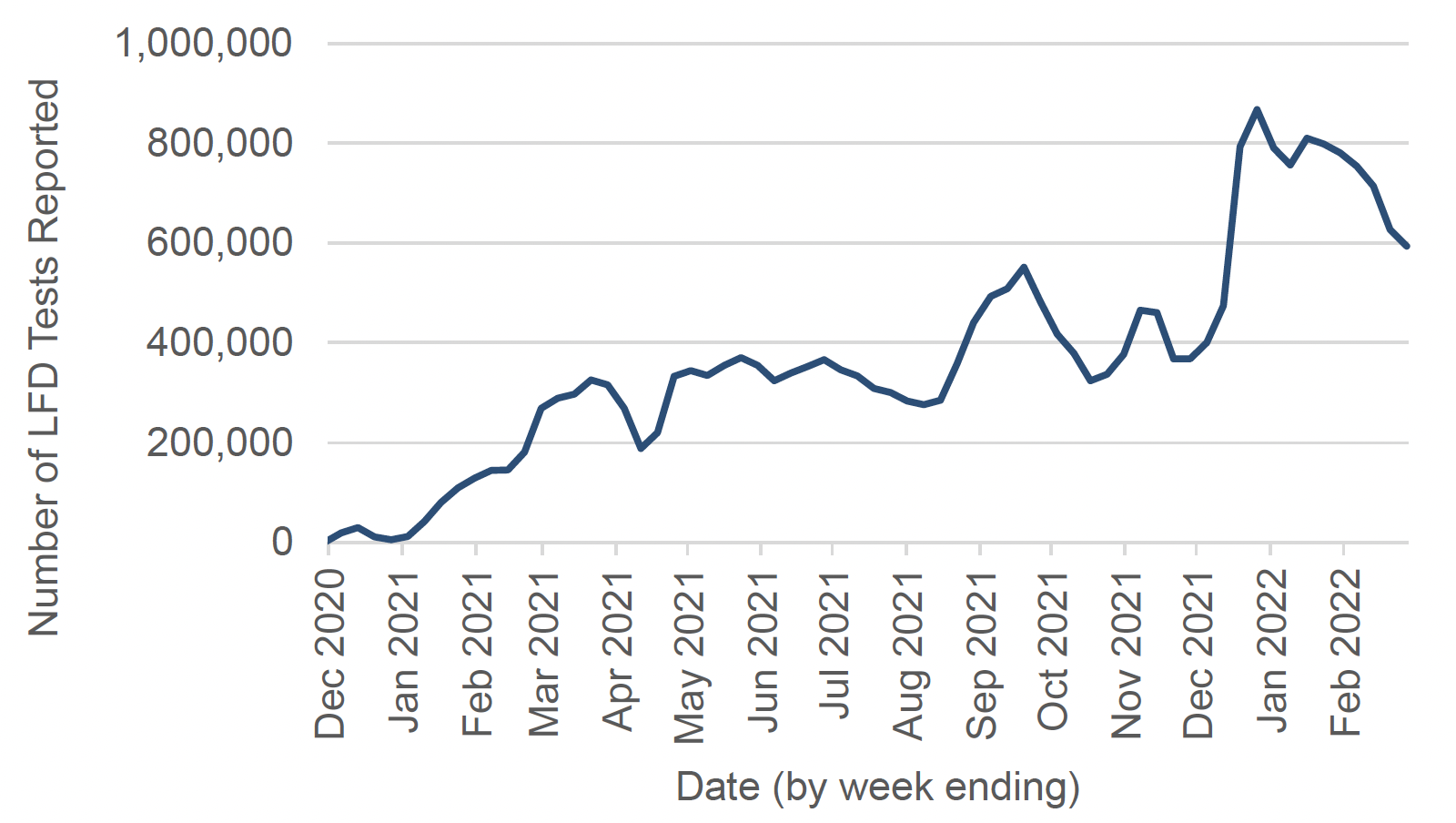
YouGov survey results have shown that on 15 to 16 February, 52% of respondents had taken a LFD/antigen test and 9% a PCR test in the past week[28]. Of those who had taken a LFD/antigen test, 45% recorded the result of their last LFD/antigen test online and 50% did not record the results online[29].
The Scottish Contact Survey asks whether people use LFD tests and if so how often. Approximately 80% of individuals had taken at least one lateral flow test within the last 7 days for the survey pertaining to the 17 February to 23 February[30].
There are differences in the results from the YouGov and the Scottish Contact Survey (SCS) which may be likely to be due to differences in sampling and methodology. YouGov is an online survey based on an active sample which is representative of the Scottish population with around 1,000 respondents[31]. The SCS[32] is based on a longitudinal survey with a larger sample of around 3,000, with the responses being modelled to represent the Scottish population.
Contact
There is a problem
Thanks for your feedback